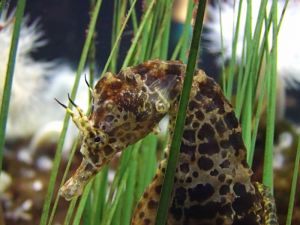Tag Archives: Tampa
Great white shark turns our to have weak bite
A research group[1] studying the hunting ability of the great white shark has found evidence indicating that this notorious predator actually has a fairly weak bite. In several movies – including the legendary Spielberg film “Jaws” – the great white shark has been portrayed as a hunter blessed with an exceptionally strong bite, but the allegedly fierce jaw power of Carcharodon carcharias is now being questioned.
According to research leader Dr Daniel Huber of the University of Tampa in Florida, sharks actually have very weak jaws for their size and can bite through their prey mainly thanks to their extremely sharp teeth – and because they can grow to be so large.
Photo by Terry Goss, copyright 2006
“Pound for pound, sharks don’t bite all that hard,” says Dr Huber. Compared to mammals, sharks have amazingly weak bites for their size. Lions and tigers are for instance equipped with much more jaw strength than sharks when you account for body size. According to Huber, mammals have evolved much more efficient jaw muscles.
During the study, Dr Huber and his team studied 10 different shark species. The bites of small sharks were fairly easy to measure, while large sharks had to be knocked out and subjected to mild electricity in order to stimulate their jaw muscles.
As mentioned above, sharks don’t really need strong jaws since they can grow so large and are fitted with extraordinarily sharp teeth. In addition to this, they also benefit from having very wide jaws. When they tear an animal apart, they frequently use a sawing motion.
Dr Huber hopes that their study will lead to the development of protective swim wear and other types of shark-proofing gear.
If you wish to read more, you can find the study “Is Extreme Bite Performance Associated with Extreme Morphologies in Sharks?” in the journal Physiological and Biochemical Zoology.
http://www.journals.uchicago.edu/doi/abs/10.1086/588177?prevSearch=(shark)+AND+[journal%3A+pbz]
[1] Daniel R. Huber, Department of Biology, University of Tampa, 401 West Kennedy Boulevard, Box U, Tampa, Florida 33606;
Julien M. Claes, Marine Biology Lab (BMAR), Catholic University of Louvain, Bâtiment Kellner, niveau D-1, 3 place Croix du Sud, B-1348 Louvain-la-Neuve, Belgium;
Jérôme Mallefet, Department of Organismic and Evolutionary Biology, Harvard University, 26 Oxford Street, Cambridge, Massachusetts 02138;
Anthony Herrel, Department of Biology, University of Antwerp, Universiteitsplein 1, B-2610 Antwerpen, Belgium
______________________________________________________________________
New article here on AC Red-striped Rasbora
Multi-million dollar marine life contraband ring busted by the Florida Fish and Wildlife Commission
A six-month long investigation by the Florida Fish and Wildlife Commission (FWC) has led to the arrest of seven adults and one juvenile in Tampa. The arrested persons are believed to have been involved in various illegal activates concerning marine life, including catching protected sharks, sea horses, peppermint shrimp and bay scallops in Floridian waters, and exporting illegally obtained marine life to Europe. They are also suspected of having sold bait fish and bait shrimp as food for human consumption.
According to the FWC, the ring is believed to have operated for at least five years before attracting the attention of FWC. The ring lost a lot of animals due to poor maintenance, but the FWC still believes the group managed to sell $600,000 worth of peppermint shrimp alone.
The Florida Fish and Wildlife Conservation Commission came into existence on July 1, 1999. The Investigations Section of the commission conducts both overt (uniform) and covert (plainclothes) investigations, and one of their tasks is to target hard-core commercial violators by conducting long-term undercover investigations. In 2003, the Investigations Section made 554 arrests/warnings and seized 130 illegally possessed specimens of fish and wildlife including a cougar, tigers, leopards, primates, exotic deer, venomous reptiles, protected birds and exotic aquatic species.

